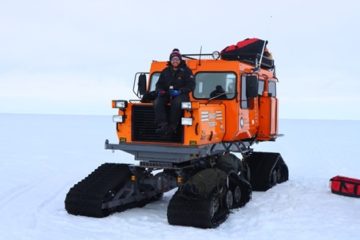Happy at Halley
2 February, 2022 Halley
Neil Brims is the Electrician at Halley VI Research Station. In our latest blog, find out what life is like at Halley and how it feels to live at the end of the Earth.
Today the sun is high in the sky and not a cloud to be seen. As you crunch through the dry, powdery snow in a southerly direction you know that there is pretty much nothing between you and the South Pole. With the sun on your back burning through your clothes you can be overheated and cold at the same time. As you breathe the cool sharp air that catches you by surprise with nearly every breath taken, you can find yourself, between jobs, appreciating the simpleness of your own existence and how hard it is to maintain it here. Merely a spec within the enormity of the continent that is Antarctica.
There are no hangers-on here, everyone has a part to play to maintain the science and to prep for future science projects. There is much to do in a very short season, this time is no exception. Air sampling flasks must be changed, generators must be maintained and repaired, new science equipment needs to be installed and buildings raised or moved – the list is endless. As the station’s Electrical Technician, I carry out the maintenance of critical safety systems like fire alarms and lighting and any associated repairs that arise, through to electrical upgrades on equipment and buildings essential for the science programme to expand. Winter is coming and it is a race to the end, fitting in as much in as is safely possible.
Life at Halley is what you make of it. It can be hard at times and at other times easy, everyone has their good days and bad days. However, everyone is looking out for one another and that is the best thing about Halley. The science is important and very interesting but for me it’s the people that make the experience so good. Getting their ‘craic’ and seeing folk just being themselves makes it such a great place to work. Just a few days ago, ten of us were off station assisting with digging up some science equipment – we had to go down nearly eight metres of snow and ice by hand to get it. Even though I work on my own most of the time, to be reminded of the team feeling was great!

Compared to the early days of Antarctic life we have it good at Halley. There are always things that you miss from ‘home life’ and yes, you miss your family. However, when you are here the 30 or so people are your family for the short few months of the season. I cannot think of any other organisation where within that group you will have mechanics, joiners, vehicle operators, doctors, medics, electronics engineers, PhD students, glaciologists, telecoms engineers, IT engineers, atmospheric chemists, field guides, pilots, meteorologists and electricians. It is so interesting to learn and get to know everyone’s work and home lives, their hobbies and interests. When I came to Halley for my first season, it was surprising how many of the group came from a farming background, nearly a third! You might think that this is an odd observation to make, however as I’m a farmer when I’m not at Halley, I find it quite interesting. In some ways if it wasn’t for an advert in a farming magazine I probably wouldn’t even be here!
The Brunt Ice Shelf, where Halley is located, borders the Antarctic coast of Coats Land between Dawson-Lambton Glacier and Stancomb-Wills Glacier Tongue. It was named by the UK Antarctic Place-names Committee after David Brunt, a British meteorologist who was responsible for initiating the Royal Society Expedition to this ice shelf in 1955. The shelf is approximately 200m deep and currently is moving out into the sea at 800m per year. The way it moves is very interesting. The Macdonald Ice Rumples, marks an area where the seabed rises. This creates a contact between the ice and the bed and provides back-stresses that stabilise the ice shelf. However, the stresses in the ice have also caused several major cracks – Chasm 1, Chasm 2 and Halloween Crack to form. A large piece of the shelf calved in early 2021. One of these, Chasm 1, has nearly formed a new iceberg, with only 800m holding the future iceberg to the rest of the ice shelf, so the million-dollar question is when it will break away. The glaciologists here have a network of instruments across the ice shelf to monitor its movement and stability, in fact, it is probably the most instrumented and closely monitored ice shelf in the world. Using this data, BAS decided to move the station to its current safe location in 2017, well away from the new iceberg that is developing.
Halley VI is currently run as a Summer-only Research Station. Traditionally it was a year-round station with a small team wintering and extra summering staff between November and February to carry out the bigger jobs and prep for the following winter. Due to new chasms in the ice, wintering at Halley is currently paused until the stability of the ice shelf is confirmed following the anticipated calving event. As the station moves into a new era of operation much of the wintering science is or has been automated, this is set to continue going forward.
For some they will only make the trip once and for others they will experience the indescribable draw to the continent and come back year after year, it is very individual. As a returner I still cannot explain or give a thorough reason why I like being here. I just hope I can be back again in the future!
Neil Brims